#nautilidae
Text
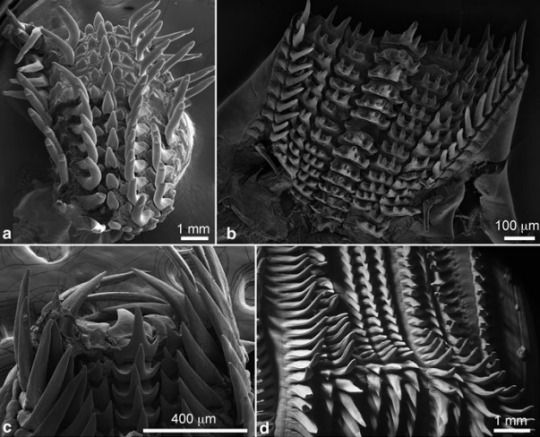
Micrographs of radulae of recent cephalopods
a) Radula of Nautilus pompilius (Nautilidae, Nautiloidea). UMUT unregistered specimen. From off Suva, Fiji.
b) Radula of Japetella diaphana (Octopoda, Amphitretidae).
c) Radula of Loligo pealei (Loliginidae, Coleoidea).
d) Radula of Dosidicus gigas (Humboldt squid, Ommastrephinae, Coleoidea)
From Isabelle Kruta, Neil H. Landman and Kazushige Tanabe's "Ammonoid Radula" via ResearchGate
2 notes
·
View notes
Text
Taxonomy Tournament: Cephalopods


Sepiida. This order is made up of cuttlefish, which have an internal shell called the cuttlebone that is used to control buoyancy.
Nautilida. This order is made up of nautilis, which have a unique planispiral shell, and move via jet propulsion. They're morphologically veyr similar to their ancient relatives, and are often called living fossils.
#animals#biology#polls#poll tournament#zoology#cuttlefish#molluscs#cephalopods#spiralia#nautilis#Sepiida#Nautilida#0x29v0x56
223 notes
·
View notes
Photo
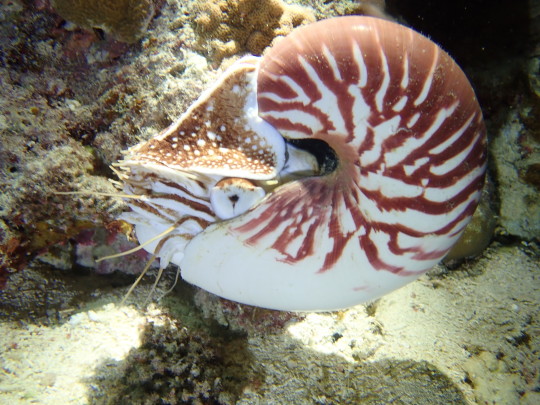
Chambered Nautilus (Nautilus pompilius)
Family: Nautilus Family (Nautilidae)
IUCN Conservation Status: Unassessed
The fossil record shows that hard external shells were common among early cephalopods, but today the six living species of nautilus are the last cephalopods to retain the external shells of their ancestors, limiting their agility and flexibility but providing them with a highly effective defence against predators (primarily octopuses and large fish) and granting them a high degree of control over their buoyancy: within the shell of a nautilus there are several chambers with a tube-like structure across which gas and water can be transferred, known as a siphuncle, running between them - by filling a chamber with gas the nautilus can increase its buoyancy, by filling a chamber with water it can decrease its buoyancy, and by balancing the number of gas-filled chambers and water-filled chambers it can maintain neutral buoyancy. The Chambered Nautilus is the largest living nautilus (with exceptionally large individuals having a shell diameter of up to 25cm/10 inches, although smaller sizes are more typical), and can be found in the Indian and western Pacific oceans where it typically inhabits shallow coastal waters and coral reefs. It swims by forcing water out of a flexible tube-like structure near its head called a siphon (which can be aimed to alter its direction of movement), and feeds largely on carrion and detritus which it locates using a pair of chemical-sensitive structures that protrude from above its eyes, known as rhinophores. Although they lack true tentacles, Chambered Nautiluses possess as many as 90 small limbs beneath their eyes (called cirri), which lack the strength and adhesive suction cups of the limbs of squids and octopuses but are capable of grasping carrion (as well as the occasional live animal, such as small crabs) and transporting it to the small, parrot-like beak hidden beneath them. When food is abundant Chambered Nautiluses often gorge themselves, storing excess food in a muscular pouch-like organ called a crop where it can be slowly released into the stomach when it is needed. Chambered Nautiluses reproduce by laying eggs (which are typically hidden in cracks in rocks or between lobes of coral, and hatch after about a year into small but fully-developed young instead of the larvae seen in most cephalopods), and while most cephalopods reach maturity, mate and die within just a few years nautiluses are relatively long-lived, reaching maturity at around 5 years old and potentially living for 15-20 years. The interior of a Chambered Nautilus’ shell is lined with a beautiful silvery substance known as nacre or mother-of-pearl which helps to protect the internal organs if the outer shell is damaged, and the demand for nacre (as well as full nautilus shells) for use in decorations and jewellery has led to a high rate of both legal and illegal hunting of this species, resulting in the Chambered Nautilus being classified as a CITES Appendix II species in 2016 (essentially meaning that they are not currently threatened with extinction, but are now legally protected so as to prevent them from being put at risk of extinction in the future.)
--------------------------------------------------------------------------
Image Source: https://www.inaturalist.org/taxa/123467-Nautilus-pompilius
#Chambered Nautilus#Nautilus#naurtiluses#nautiloids#cephalopods#zoology#biology#Teuthology#animal#animals#marine wildlife#marine biology#cephalopod#wildlife
444 notes
·
View notes
Photo

Nautilus are a large swimming marine molluscs restricted to a handful of species in the family Nautilidae from around the Coral Triangle, a roughly triangular area in the tropical waters located between the Pacific and Indian oceans. They are conformes by two different groups, fuzzy nautilus (Allonautilus) and common nautilus (Nautilus) with nearly eleven species, as researchers have recently added three new nautilus species.
A previous work showed a difference in genomic along different populations, now a international team of researchers combined previous work with image analysis software,using pigmentantion, shape and total shell area of they data set, confirming the presence of three unnamed species, here as Nautilus samoaensis, Nautilus vanuatuensis and Nautilus vitiensis.

According to researchers, nautilid shells implode at depths greater than 800 m and depth therefore acts as a biogeographical barrier separating these species.
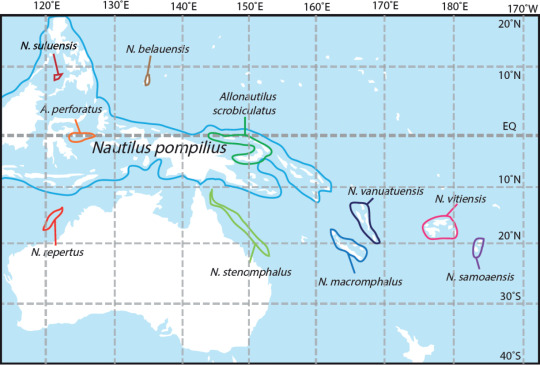
-Where all Nautilus species distributed in the Coral Sea and the South Pacific.
According to researchers, all nautiluses are regulated under appendix II of the Convention on International Trade in Endangered Species (CITES). At the moment, no species of Nautilus or Allonautilus has been formally assessed by the International Union for Conservation of Nature Red List. All they face illegal trade. This study may provides a foundation for managers and other officials to begin to efficiently identify distinct species of nautilus shells that may come through as trade products.
Photo: Underwater photos of living Nautilus new species A, B Nautilus samoaensis C Nautilus vanuatuensis and D Nautilus vitiensis.
Reference (Open Access): Barord et al. 2023. Three new species of Nautilus Linnaeus, 1758 (Mollusca, Cephalopoda) from the Coral Sea and South Pacific. ZooKeys.
#new species#nautilus#nautilus vitiensis#nautilus samoaensis#nautilus vanuatuensis#science#marine science#coral sea#south pacific#pacific#cephalopoda#mollusc#animals#marine biology#biology#sciblr#scienceblr
374 notes
·
View notes
Text

Inès, Nautilidae
© Chill · +
121 notes
·
View notes
Text



Hi hello! Levihan fans!!! Im selling levihan stickers over on Etsy, currently this is the only design I have photos for but I have another coming out hopefully this week.
If you’re interested, my shop is https://www.etsy.com/ca/shop/Nautilidaes !!
I love making Levihan content please give me an excuse to sell more and spread the agenda
23 notes
·
View notes
Note
That ask about aquatic creatures reminds me of a sort of dragon-esque thing I designed and decided to call a nautilus (it's also a particular species of dragon). Maybe there could be like a mini version of it?
I'm not sure what the dragon you mentioned looks like so I can't say, but real life Nautilidae could be a fun inspiration, so thanks for bringing them to my attention!
5 notes
·
View notes
Note
Hello! Following Milk's idea, any other topics or fun facts you want to talk about? I hope you're having a good day!
Oh hoh hoh!! Another change to spit out random facts I know? Thank you very much, Moth!!
(I hope you are having a lovely day yourself! *hugs you*)
The topic today is statocysts, specifically those of cephalapods!
Secondary fun fact to start us off: translated literally, "cephalopod" (Squid, octopi, nautilidae, cuttlefish, or other members of the molluscan class Cephalopoda) means "Head-feet"! Which, if you've ever looked at an octopus, you can understand:
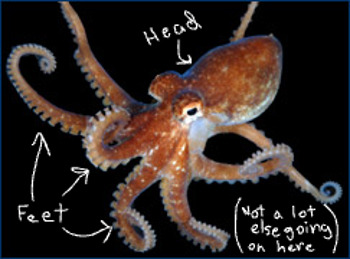
So. Cephalaopods live in the water, right? This means they don't hear the same way humans, or indeed most vertebrates do. Humans hear because the sound hits the eardrum, gets passed on through middle and inner ear, and then is sent up the auditory nerve to the brain.
Cephalopods have two sacs near the base of their brain called statocysts. They're filled with fluid and lined with hair cells that connect to the brain via nerves. This makes them similar to human ears, except that statocysts have a little piece of calcium carbonate inside them called a statolith.
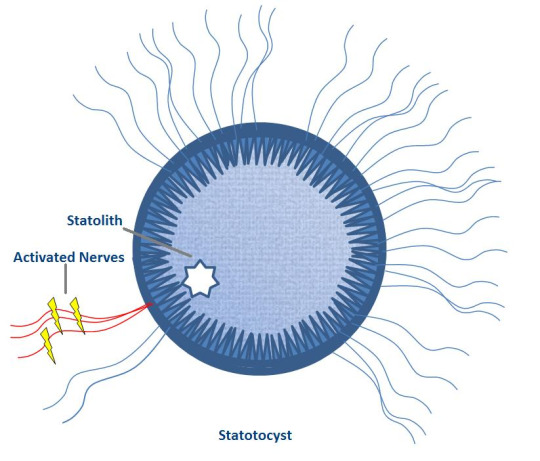
When the cephalopod moves, the statolith moves around too, which allows the hair cells, and therefore nerves and brain, to process the movement. This is a little like how the human vestibular system detects balance and equilibrium. (How you know if you're upright or leaning to the side, laying down, etc.)
However, since cephalopods have these statocysts instead of vertebrate ears, they do not exactly "hear" sound, but instead sense how fast particles are accelerating due to the vibrations that a human might hear audibly.
This became a field of study partially because of an abnormal amount of dead squid washing up on beaches in the early 2000s. It was discovered that certain human equipment, such as sonar or air guns used to search for oil, were damaging the statocysts in nearby cephalopods. The sounds caused lesions, swollen nerves, and other injuries that would have caused the squid to lose their ability to orient themselves.
This spurred on a more direct look into how human technology is affecting marine life, as well as the vastly unknown field of cephalopod sensory processing.
Here are some sources for those who are curious:
>1
>2
>3
#I'm sorry this took me a while#I read about this several years ago and I wanted to be sure none of my information was out of date#I hope I didn't make any mistakes in this summary#(And my deepest apologies if I did)#I just think it's interesting#We don't know a lot about the head-feet so there's a lot of neat studies going on#Going to shut up now#not mbs#asks
9 notes
·
View notes
Text
pinned post / info
(last updated 2/5/24)

noa/neo/ozo (ozo preferred unless you knew me before i chose it as a name)
22 (dec 14th)
he/its/17self/nyaself/🍝self pronouns
im currently trying to reclaim my chicano identity after years of denying it
dni: minors (if youre like. a few months from turning 18 youre fine idc), proshippers, transphobes, homophobes, racists etc. etc. ill just block you if you ignore this
i am very bad at remembering to tag triggers, especially uncommon ones. feel free to unfollow if this is a dealbreaker
i smoke weed and post about it. i dont tag it. dont ask me to.
too lazy to change my desktop theme, info there is out of date
look below the readmore for more info abt my blog
content you might see on here:
random textposts. i love chatting aimlessly to myself and i use this blog like the journal it was meant to be
memes and other funny images
political/world events posts. i dont participate in niche internet discourse, do not involve me. this includes any sort of lgbt/queer discourse
the following fandoms: trigun, locked tomb, hollow knight, adventure time, borderlands, homestuck, the edge chronicles, undertale/deltarune, splatoon, a hat in time, and pokemon. im also into fallout but i put that on a sideblog. sometimes i post about other stuff though. who knows.
sideblogs i use:
@piximatli (18+ nsft blog)
@ssozo (18+ selfship blog)
@nautilidaes (ocean/marine aes blog)
@isodopeds (fallout blog)





50 notes
·
View notes
Text
This is the main blog for:
@ubiquitous-nautilidae
@jaketiri
@weird-and-wonderful-things
@thekrath
Twitter handle is @edelgardsapphic
1 note
·
View note
Text
The chambered nautilus pdf
THE CHAMBERED NAUTILUS PDF >>Download
vk.cc/c7jKeU
THE CHAMBERED NAUTILUS PDF >> Leia online
bit.do/fSmfG
Comparação da Tíbia Shell com o padrão de crescimento da seção de ouro. Page 8. A Anatomia do Compartilhar. Chambered Nautilus. A Nautilus e Nautilidae discussion forum · Waikïkï Aquarium: Marine Life Profile: Chambered Nautilus · A molecular and karyological approach to the taxonomy of Nautilus Effective January 2, 2017: The entire family of chambered nautiluses (Nautilidae), which includes two species from the genus Allonautilus (A. perforatus and A. Ilustração esquemática do molusco Nautilus pompilius, com o animal, mostrando o sifão e suas câmaras internas de flutuabilidade; retirada de The anatomy of static1.squarespace.com/static/508dc759e4b044ecf46b82d3/t/5b207dce2b6a28afecc8b7fe/152885 · 6027944/chambered-nautilus-on-blue.jpg?format=1000w. PLEASE NOTE: THIS IS A DIGITAL CROCHET PATTERN (PDF) With this very easy Downloadable PDF pattern ~Naughty Nadia the Chambered Nautilus Crochet by Chambered Nautilus. Construção da Espiral da Seção de Ouro. Proporção áurea no corpo humano. Estudadas por Vitruvius. A altura do corpo humano e a medida do0003 Crochet Pattern - Deep-water Angler Monkfish SAM night lamp - Pdf file by Alexandra Simba Etsy. This listing is for an INSTANT DOWNLOAD PDF PATTERN, not a
https://www.tumblr.com/vudaxumiv/697798115567271936/martha-beck-books-pdf, https://www.tumblr.com/vudaxumiv/697797518064484352/pdf-xchange-tools, https://www.tumblr.com/vudaxumiv/697797518064484352/pdf-xchange-tools, https://www.tumblr.com/vudaxumiv/697797679515942912/hot-water-music-no-division-table-pdf, https://www.tumblr.com/vudaxumiv/697797518064484352/pdf-xchange-tools.
0 notes
Text
Taxonomy Tournament: Cephalopod Finale!
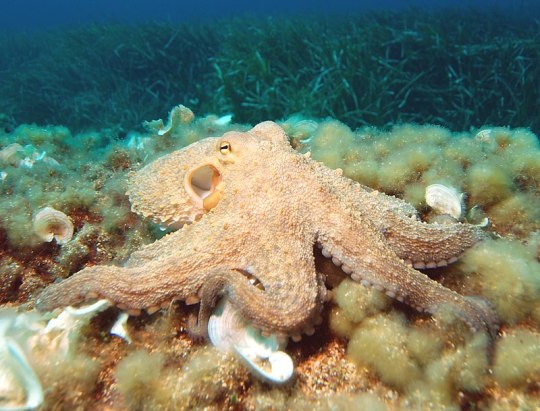
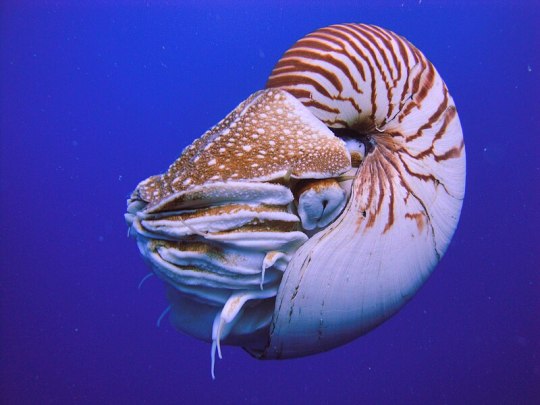
Octopoda. This order is made up of octopuses, predatory marine creatures with eight limbs. Their soft body allows them to squeeze trhough small spaces. They are capable of camouflage and are among the most intelligent animals.
Nautilida. This order is made up of nautilis, which have a unique planispiral shell, and move via jet propulsion. They're morphologically veyr similar to their ancient relatives, and are often called living fossils.
#animals#biology#polls#poll tournament#zoology#octopus#octopi#octopuses#molluscs#cephalopods#spiralia#nautilis#Octopoda#Nautilida#0x15v0x2a
120 notes
·
View notes
Photo
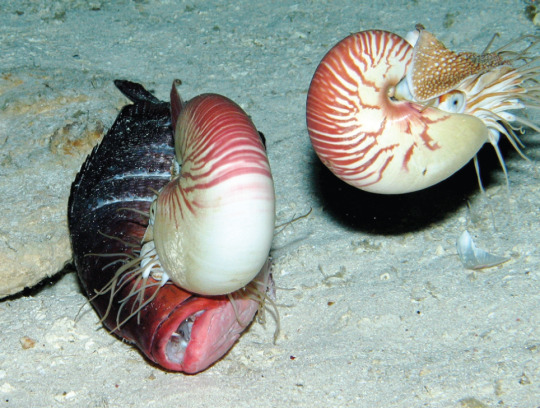
Deepest record of Nautilus – 703 meters.png
458 notes
·
View notes
Text

🌊🌿🐚🦑
#Water#Ocean#Sea#Underwater#Coral#Reef#Coral Reef#Nautilus#Nautilidae#Mollusc#Fish#Art#App#Adult Colouring Book#Adult Coloring Book#Tap Color - Color By Number#My Post#My Upload
2 notes
·
View notes
Photo
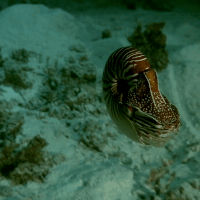
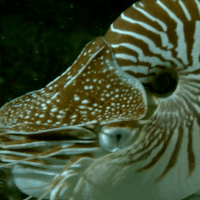


Nautilus Grooves - Please credit us if you use!
#gifs#animal stims#sea creatures#nautilus#nautilidae#mollusca#siri save#mew queue#our stuff#trypophobia
28 notes
·
View notes
Photo
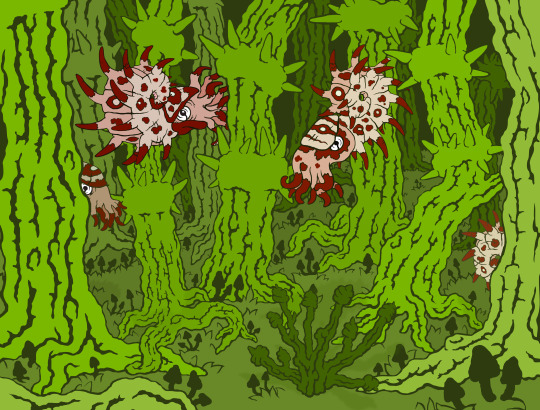
Some places remember what they used to be.
#fantasy art#magical forest#extinct creatures#cooperoceras#nautilidae#art by me#i did not go for accurate as much as moody
6 notes
·
View notes